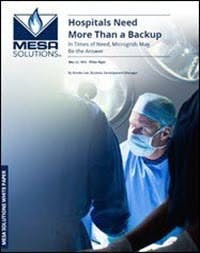Microgrids Provide Hospitals Energy Security in Times of Need
Standby generators can provide short-term emergency power for hospitals, but as energy interruptions grow more frequent and last for longer periods of time, our health care facilities need more reliable, robust and resilient backup power systems. A new white paper from Mesa Solutions explores how microgrids provide hospitals with energy security in times of need.
Get the full report.
Hospitals are one of the largest consumers of commercial energy in the US. Diagnostics equipment, lifesaving medical devices, complex HVAC systems and thousands of employees demand power to provide care to the hospital’s patients. Traditionally, standby generators have been the source of power in a time of crisis, but they aren’t the most resilient solution. Generators aren’t meant to run for long periods of time, “and may not be able to carry 100% of a hospital’s large power load,” according to the paper. “A microgrid can carry a hospital’s full power load through outages lasting for weeks or even months.”
A microgrid provides more than just energy security during times of crisis. The paper says that many hospitals use microgrids to reduce costs and meet their sustainability goals. Because the microgrid becomes a part of the facility’s energy mix, on-site generators and energy storage can be used to offset high energy prices, meaning the system “delivers value at all times, not just during power outages.”
“A complete microgrid solution intelligently coordinates a variety of onsite and offsite power sources to optimize costs and stability, including the option to be fully off-grid and self-supported during outages or disturbances.” — Mesa Solutions, “Hospitals Need More Than a Backup”
Hospitals can see other financial benefits from their microgrids as well. “Where regulations and the contract agreement allow it,” the paper’s author notes, “the hospital can also sell excess capacity to the local utility or wholesale market.”
The report describes the natural gas-fueled generator developed by Mesa Solutions. It says the Mesa PowerCore is “designed to function within a microgrid.” Because it’s a modular system, multiple units can be stacked to provide solutions for a wide range of power needs. The author also describes the services provided by Mesa Solutions’ Operations Center, including the use of a telemetry system to monitor the generator units 24/7.
Download the full report from Mesa Solutions to learn more about how microgrids provide hospitals with energy security during times of need as well as cost savings and new revenue streams to achieve financial goals.
Learn more about Mesa Solutions.
About the Author
Kathy Hitchens
Special Projects Editor
I work as a writer and special projects editor for Microgrid Knowledge. I have over 30 years of writing experience, working with a variety of companies in the renewable energy, electric vehicle and utility sector, as well as those in the entertainment, education, and financial industries. I have a BFA in Media Arts from the University of Arizona and a MBA from the University of Denver.


